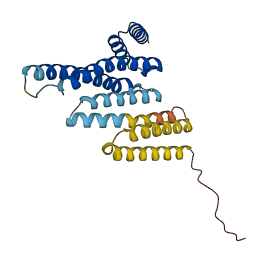Descriptions
The autoinhibited protein was predicted that may have potential autoinhibitory elements via cis-regPred.
Autoinhibitory domains (AIDs)
Target domain |
|
Relief mechanism |
|
Assay |
cis-regPred |
Accessory elements
No accessory elements
Autoinhibited structure

Activated structure

1 structures for Q2R1D5
| Entry ID | Method | Resolution | Chain | Position | Source |
|---|---|---|---|---|---|
| AF-Q2R1D5-F1 | Predicted | AlphaFoldDB |
No variants for Q2R1D5
| Variant ID(s) | Position | Change | Description | Diseaes Association | Provenance |
|---|---|---|---|---|---|
| No variants for Q2R1D5 | |||||
No associated diseases with Q2R1D5
1 regional properties for Q2R1D5
| Type | Name | Position | InterPro Accession |
|---|---|---|---|
| domain | 14-3-3 domain | 4 - 225 | IPR023410 |
1 GO annotations of cellular component
| Name | Definition |
|---|---|
| cytoplasm | The contents of a cell excluding the plasma membrane and nucleus, but including other subcellular structures. |
No GO annotations of molecular function
| Name | Definition |
|---|---|
| No GO annotations for molecular function |
2 GO annotations of biological process
| Name | Definition |
|---|---|
| protein localization | Any process in which a protein is transported to, or maintained in, a specific location. |
| signal transduction | The cellular process in which a signal is conveyed to trigger a change in the activity or state of a cell. Signal transduction begins with reception of a signal (e.g. a ligand binding to a receptor or receptor activation by a stimulus such as light), or for signal transduction in the absence of ligand, signal-withdrawal or the activity of a constitutively active receptor. Signal transduction ends with regulation of a downstream cellular process, e.g. regulation of transcription or regulation of a metabolic process. Signal transduction covers signaling from receptors located on the surface of the cell and signaling via molecules located within the cell. For signaling between cells, signal transduction is restricted to events at and within the receiving cell. |
18 homologous proteins in AiPD
| UniProt AC | Gene Name | Protein Name | Species | Evidence Code |
|---|---|---|---|---|
| Q04917 | YWHAH | 14-3-3 protein eta | Homo sapiens (Human) | PR |
| P61981 | YWHAG | 14-3-3 protein gamma | Homo sapiens (Human) | PR |
| P27348 | YWHAQ | 14-3-3 protein theta | Homo sapiens (Human) | PR |
| P31946 | YWHAB | 14-3-3 protein beta/alpha | Homo sapiens (Human) | PR |
| P63104 | YWHAZ | 14-3-3 protein zeta/delta | Homo sapiens (Human) | PR |
| P68510 | Ywhah | 14-3-3 protein eta | Mus musculus (Mouse) | PR |
| P63101 | Ywhaz | 14-3-3 protein zeta/delta | Mus musculus (Mouse) | PR |
| P63102 | Ywhaz | 14-3-3 protein zeta/delta | Rattus norvegicus (Rat) | PR |
| Q06967 | GF14F | 14-3-3-like protein GF14-F | Oryza sativa subsp japonica (Rice) | PR |
| Q7XTE8 | GF14B | 14-3-3-like protein GF14-B | Oryza sativa subsp japonica (Rice) | PR |
| Q84J55 | GF14A | 14-3-3-like protein GF14-A | Oryza sativa subsp japonica (Rice) | PR |
| Q2R2W2 | GF14D | 14-3-3-like protein GF14-D | Oryza sativa subsp japonica (Rice) | PR |
| Q6ZKC0 | GF14C | 14-3-3-like protein GF14-C | Oryza sativa subsp japonica (Rice) | PR |
| Q96453 | GF14D | 14-3-3-like protein D | Glycine max (Soybean) (Glycine hispida) | PR |
| Q96452 | GF14C | 14-3-3-like protein C | Glycine max (Soybean) (Glycine hispida) | PR |
| Q96299 | GRF9 | 14-3-3-like protein GF14 mu | Arabidopsis thaliana (Mouse-ear cress) | PR |
| P93213 | TFT8 | 14-3-3 protein 8 | Solanum lycopersicum (Tomato) (Lycopersicon esculentum) | PR |
| P93214 | TFT9 | 14-3-3 protein 9 | Solanum lycopersicum (Tomato) (Lycopersicon esculentum) | PR |
| 10 | 20 | 30 | 40 | 50 | 60 |
| MKEREKVVRL | AKLAEQAERY | DDMVEFMKTL | ARMDVDMSAE | ERLLFSVGFK | KTIGARRASW |
| 70 | 80 | 90 | 100 | 110 | 120 |
| RILESLEQKV | TAGDQPGVTI | NGYKKKVEDE | LRAVCNEVLS | IIAIHCLPLA | NSGENVVFFY |
| 130 | 140 | 150 | 160 | 170 | 180 |
| KMKGDYYRYL | AEFSTGTEKK | AATDQSLMAY | QAWPCAQLFS | LLEIMNSPER | ASQVAKQALD |
| 190 | 200 | 210 | 220 | ||
| EATAEINSAG | VEGYKDSMLM | MQLLKENLAL | WTSELTGGET | SKDDDVVMEG |
